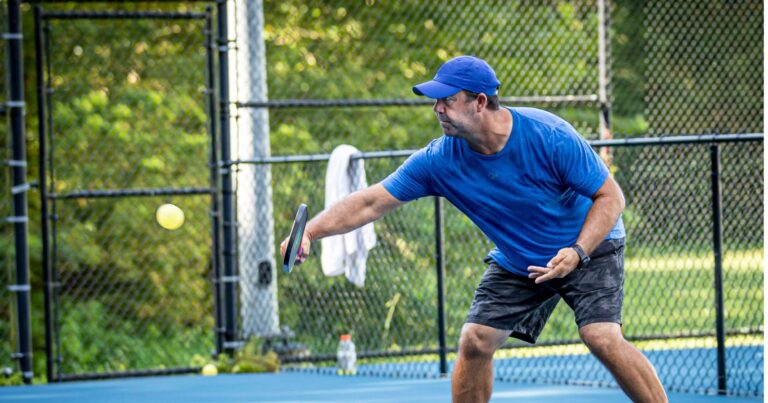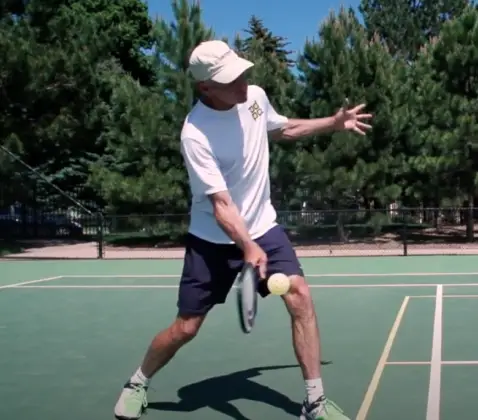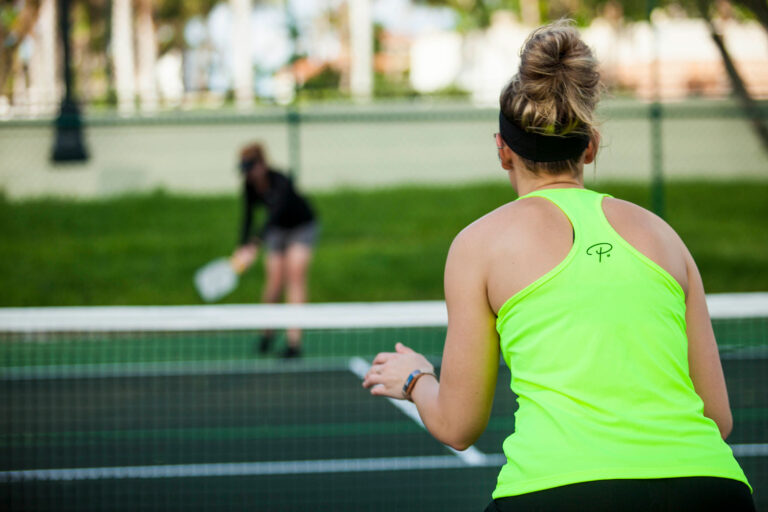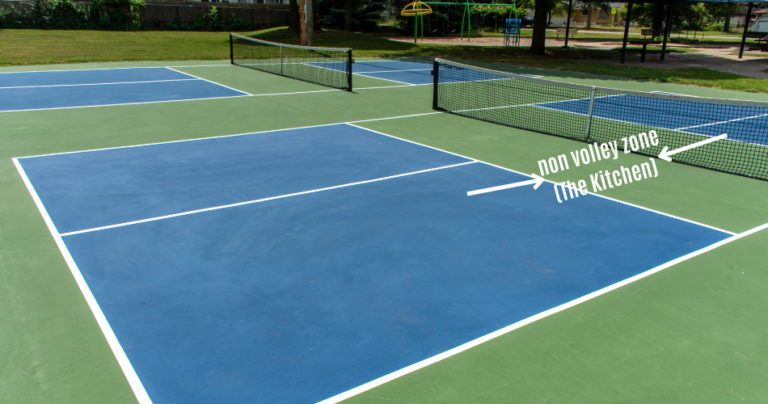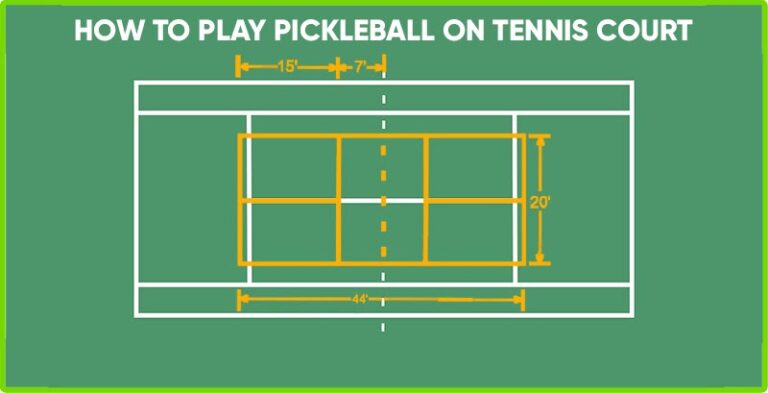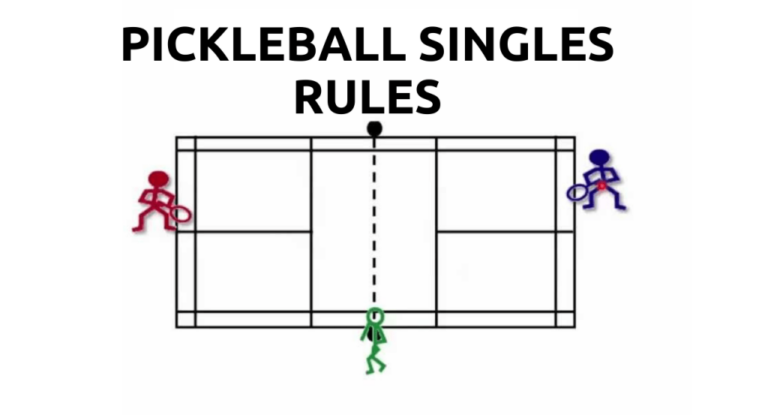Diving into Doubles: Pickleball Rules Doubles and Strategies
Pickleball Rules Doubles
In doubles pickleball, you serve underhand diagonally, and only the serving team scores. Keep in mind the double bounce rule: the serve must bounce once on each side before being returned. Be careful crossing the non-volley zone while volleying – it’s a fault. Make sure your volleys and serves aren’t above waist level. Effective volley technique and strategic court positioning with your partner are essential. And remember, a ball touching any line (except the non-volley zone) is in. Stay tuned, there’s more to learn about master strategies and avoiding common mistakes.
Main Points
- In doubles pickleball, serves must be underhand, below the waist, and directed to the diagonal service area.
- Scoring is exclusive to the serving team and the team rotates sides after scoring a point.
- The non-volley zone, a 7-foot area extending from the net, can be entered but not while volleying.
- The double bounce rule requires the served ball to bounce on both sides before returning.
- Avoid faults by keeping feet behind the line during a serve and ensuring paddle contact with the ball is at waist level or below.
Understanding Pickleball Serve Rules
Let’s explore understanding the serve rules in doubles pickleball, a game where the serve must be underhand and below the waist, directed to the diagonal service area. It’s a vital aspect that sets the pace for the game and your success largely hinges on mastering it.
In pickleball, each team gets one serve attempt per side-out, and the initial serving team starts the serving rotation. This means you’ve got to make your serve count. There’s no room for error since there’s no second serve. So, make sure your serve is underhand, below your waist, and headed for the diagonal service area.
After losing a point, you’ll switch sides. This rotation keeps the game dynamic and challenging. You’ll need to adjust your strategy based on your new position and the opponents’ strengths.
A notable rule in doubles pickleball is your court position depends on your serving team’s score. If it’s even, you’ll serve from the right side of the court. If it’s odd, you’ll serve from the left. Understanding these pickleball serve rules is essential to getting a good start and maintaining momentum in the game. So, grab your paddle and start practicing!
Mastering Doubles Pickleball Scoring
Now that you’ve got a handle on the serve rules, mastering the scoring in doubles pickleball is your next challenge. In doubles, scoring is exclusive to the serving team, so it’s important to serve effectively. Remember, you can’t score if you’re not serving.
After scoring a point, your team rotates sides. This rotation is more than just a rule; it’s a strategic move and promotes fairness. It guarantees that you and your partner both get equal opportunities to serve and return the ball from different sides of the court.
Faults can change the game dramatically in pickleball. If you step into the non-volley zone or hit the ball out of bounds, it’s a fault, and you lose your chance to serve or score. So, be mindful of the non-volley zone and the boundaries.
The serving sequence in doubles pickleball is important to follow. It starts with the first server, and it’s an accurate way to keep track of the score. The numbers called out by the server signify the serving team’s score first, then the receiving team’s score, and finally, the server number. This sequence isn’t just about scoring; it’s about strategy and fair play.
Effective Volley Techniques
You’ve got to nail your volley techniques to excel in doubles pickleball. Start by mastering the punch volley and soft volley, which can provide a strategic advantage during play.
Mastering the Punch Volley
In mastering the punch volley—an essential technique in doubles pickleball—you’ll need to hit the ball with a firm, controlled motion. This volley technique is particularly effective for placing the ball in hard-to-reach areas, making it difficult for your opponents to return.
To visualize this, picture these steps:
- Position your paddle at a favorable angle.
- With excellent timing and hand-eye coordination, punch the ball firmly.
- Aim for low, hard-to-reach areas near the net.
- Maintain control to set up winning shots.
Soft Volley: Strategic Advantage
Gaining a strategic advantage in pickleball doubles often hinges on mastering the soft volley, a technique that involves gently tapping the ball above the net to create challenging angles and disrupt your opponents’ rhythm.
This strategic shot, accurately placed in your opponent’s court, creates difficult angles that can force errors and open up offensive opportunities for your team. A well-executed soft volley lets you control the pace the game, maintaining constant pressure on your opponents.
But remember, it’s not just about power. Successful soft volleys require a blend touch and finesse, a keen sense timing, and the ability to adjust your shot based on the situation. So, practice that gentle tap and turn your soft volley into a game-changing weapon.
Entering the Non-Volley Zone
Let’s talk about the pickleball non-volley zone, or as it’s often called, the kitchen.
It’s important to know when and how you can step into this zone without committing a fault.
After all, understanding these rules can be the difference between a winning volley and a lost point.
Understanding Non-Volley Zone
To fully grasp the rules of pickleball doubles, you’ll need to understand the concept of the Non-Volley Zone, a critical 7-foot area extending from both sides of the net. This zone has specific rules designed to prevent players from standing inside it to volley the ball, making it an essential element of strategic play.
Consider the Non-Volley Zone as:
- A ‘forbidden territory’ during a volley, stepping on the line or inside this zone is a fault.
- A strategic area that can be entered, but not while volleying.
- The 7-foot area that extends from the net, defining a safe boundary for the opposing team.
- An integral part of the pickleball doubles, adding a layer of complexity and strategy to the game.
Understanding this zone is crucial to mastering pickleball doubles.
Non-Volley Faults Explained
Understanding non-volley faults in pickleball doubles is essential, as stepping into the non-volley zone during a volley can cost you points and potentially the game. This zone, often referred to as the ‘kitchen’, is a critical area in doubles play. The kitchen rule forbids you from executing smashes or volleys while in the non-volley zone.
A fault, by definition, is any violation of the rules. So, if you step on the line or into the kitchen during a volley, it’s a fault. Fault scenarios include net play too close to the kitchen or improper footwork. The fault consequences are severe – the opposing team earns a point. Therefore, understanding and avoiding non-volley faults is key to a successful game.
Decoding the Double Bounce Rule
In pickleball, you’ve got to let the served ball bounce on both sides before returning it, a guideline known as the double bounce rule. This rule isn’t just some arbitrary regulation; it’s a strategic player’s best friend. It applies to both singles and doubles matches, and it’s designed to promote longer rallies and fair play by preventing a quick, aggressive play at the net.
The double bounce rule works like this:
- Your team serves the ball to the opposing court.
- The receiving player lets the ball bounce before returning it.
- Your team must also let the ball bounce before hitting it back.
- After these initial bounces, players can then volley the ball or hit it off a bounce.
Making Accurate Line Calls
Now, let’s explore making precise line calls, an essential aspect of pickleball doubles matches that guarantees fair play and embodies good sportsmanship. Remember, a ball that touches any line, except the non-volley zone line on a serve, is considered in. Your ability to accurately judge this guarantees integrity and keeps the game flowing smoothly.
Stepping on the non-volley zone line during a volley results in a fault, so it’s important to be aware of your positioning. Honesty is just as significant. You’re responsible for making accurate calls on your side of the court, considering that line calls are a cornerstone of fair play in doubles matches.
Communication is key. Clear communication regarding line calls not just maintains the fluidity of the game but also fosters a sense of respect and sportsmanship among players. Remember, your honesty in line calls is a reflection of your integrity. In pickleball as in life, accuracy, fair play, and good sportsmanship should always take precedence. Make your line calls with confidence, clarity, and honesty to guarantee a fair and enjoyable doubles match.
Identifying and Avoiding Faults
Let’s explore the art of identifying and avoiding faults in pickleball doubles, a critical skill that can save you from point losses and guarantee fair play. Faults can occur in multiple scenarios, from serve to volley, and can drastically affect your game if not properly addressed.
To help create a clear picture, here are some common situations that lead to faults:
- Stepping into the non-volley zone during a volley
- Making contact with the non-volley zone line during a serve
- Hitting the ball above waist level or with the head of the paddle higher than the wrist at contact
- Failing to hit the ball in an upward arc motion during the serve
Now, let’s discuss how you can avoid these faults. Always make sure to stay outside of the non-volley zone during a volley. Keep your feet behind the line during a serve. Ensure your paddle contact with the ball is always at waist level or below, and the head of the paddle isn’t higher than your wrist. Lastly, remember to hit the ball with an upward arc motion during a serve to avoid a fault. By understanding and avoiding these faults, you can save yourself from point losses, and guarantee fair play.
Necessary Pickleball Equipment
Before diving into your next pickleball doubles match, it’s crucial to gear up with the right equipment. The cornerstone your pickleball equipment is your paddle. It’s usually made from wood, graphite, or composite materials, and its design directly impacts your game. Choose one that fits your grip and playing style.
Next in line is the ball. Unlike regular sports balls, pickleball balls are perforated plastic balls with specific hole patterns. These unique features affect the ball’s flight and bounce, adding an extra layer strategy to your match.
Your game also depends on the court. A specialized surface with defined boundaries and a non-volley zone is necessary for a proper game pickleball. This setup ensures fair play and adds complexity to the game.
Last but not least, don’t underestimate the importance good shoes. Pickleball requires quick movements, and the right shoes provide the stability, grip, and support you need.
Understanding the key equipment needed for pickleball prepares you for the game. So, equip yourself right, and get ready for the match. Remember, well-equipped players are often the most successful ones.
Strategic Court Positioning
In pickleball doubles, mastering the art for strategic court positioning can drastically improve your game, allowing you to control the net, intercept shots, and set up offensive plays effectively. Your position on the court determines how much control you have over the game and your ability to respond to your opponents’ shots.
Here are some key strategies to bear in mind:
- Move up to the kitchen line: This gives you net control and allows you to play offensively. The closer you’re to the net, the more likely you’re able to intercept shots and set up offensive plays.
- Coordinate movements with your partner: Ensure efficient coverage of the court by moving in sync with your partner. This reduces the chances of leaving open spaces that your opponents can exploit.
- Anticipate shots: Keen observation and quick reaction can help you anticipate your opponents’ shots and adjust your position accordingly.
- Balance between offensive and defensive positioning: While it’s important to be aggressive, don’t neglect your defensive positioning. Always be prepared to defend your side of the court when necessary.
Frequently Asked Questions
What Are the Rules for Double Serving in Pickleball?
In doubles pickleball, you and your partner each get one serve per side-out. The first serve is made from the right court. You switch sides after losing a point. Always announce the score before serving.
What Is the Golden Rule Pickleball?
In pickleball, the Golden Rule means treating others as you’d want to be treated. It underlines fairness and respect. Adherence guarantees a positive game, promoting a friendly environment where everyone can enjoy and improve.
How to Score in Pickleball Doubles?
In pickleball doubles, you only score when serving. Keep serving until you fault. After a fault, it’s the opponent’s turn. The first server follows a rotation pattern based on the score. Keep track!
What Are the Basic Pickleball Rules?
In pickleball, you serve diagonally, stay clear of the ‘kitchen,’ and only score when serving. It’s important to avoid faults, like hitting out of bounds, and remember to switch sides after scoring a point.
Conclusion
So, there you have it! Now you’re well-equipped with the rules and strategies for doubles pickleball.
From mastering the serve, understanding scoring, to making accurate line calls and avoiding faults, you’re set to hit the court.
Don’t forget the necessary equipment and remember, practice makes perfect.
Now, all that’s left is to get out there, apply these tips, and enjoy the game. Happy playing!

